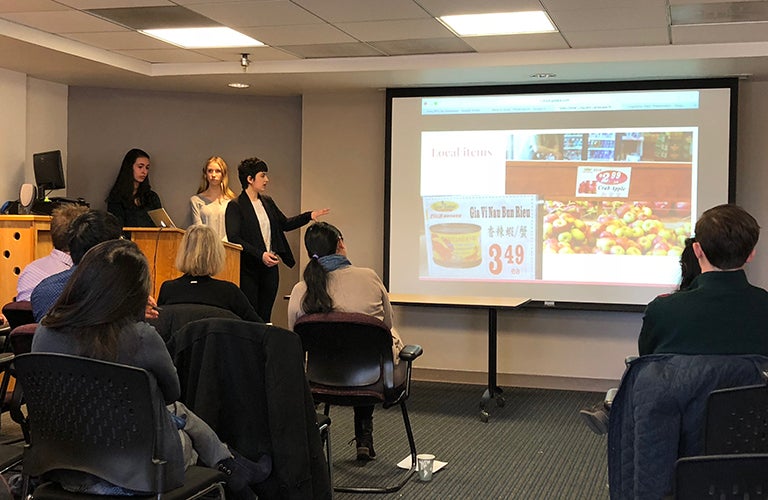Students Showcase Linguistics Research

Laura Bomeny (C’19), Peyton Shelburne (C’20), and Kiren Chaudry (C’20) present research on linguistic landscapes in Eden Center, a Vietnamese business district in northern Virginia.
April 23, 2018 — Six undergraduates from Georgetown College and the Walsh School of Foreign Service presented their research on linguistic landscapes to a group of peers, professors, and community stakeholders last month at a Department of Linguistics event.
“Multilingualism of the DC metro area: A student research showcase,” held in Poulton Hall, featured three presentations of original research on linguistic landscapes — the study of language visibility, salience, and representation in a geographical region — in the D.C. metro area.
ACCESSIBLE RESEARCH
The event took shape in meetings of the Initiative for Multilingual Studies, according to organizer Nic Subtirelu, a professor in the Department of Linguistics.
“We tried to combine student research and opportunities to interact with Washington, D.C.,” Subtirelu said. “Linguistic landscape is an emerging field that uses methods accessible enough for undergrad students to use without much special training.”
Three courses in the Fall 2017 semester incorporated linguistic landscapes research projects into their curricula, and professors were asked to nominate their favorite presentations to Subtirelu and co-organizer Jason D’Angelo, a Ph.D. student in linguistics, who selected one from each class.
“We picked one from each class and tried to show the most variety,” Subtirelu said. “That’s important because, for example, there were a few projects on Mount Pleasant and the goal was to try and show lots of different research”
STUDENT PRESENTATIONS
Leonor Morrow (F’19), a culture and politics major, opened the event with “Back to good: Analyzing the language accessibility of D.C. public transit,” a presentation on language accessibility in Metro stations.
Even though 30 percent of D.C. area residents speak a language other than English at home, Morrow found that non-English languages on the Metro were usually confined to temporary advisories, which may contribute to residents with poor economic proficiency using Metrorail at a much lower rate.
Cecilia Castillo Ayometzi, a workforce diversity and compliance officer at the Washington Metropolitan Area Transit Authority, attended the presentation and provided Morrow with feedback. Morrow hopes to expand her research to more stations with the help of the Georgetown University Research Opportunities Program.
Laura Bomeny (C’19), Kiren Chaudry (C’20), and Peyton Shelburne (C’20) took the podium next with “A capital within a capital: Linguistic landscape at Eden Center,” a group presentation on the Vietnamese commercial district in Falls Church, Va.
They found that Vietnamese was much more likely to appear on public signs and on locally made commercial signs in Eden Center, while commercial signs that hadn’t obviously been handmade by a local vendor were much more likely to feature English or Chinese. The group connected this trend to the globalized economy, as well as the influx of Chinese families to the area within the last decade.
The final presentation featured qualitative research on Spanish language use by Isabella Day (C’18) and Joe Donohue (C’18) in “True bilingualism: The double usage of language in Mount Pleasant.”
Inspired by a 2009 study that argued the use of Chinese in D.C.’s Chinatown neighborhood has become “less a means of communication and more a symbolic design element, an ornament in the commodified landscape,” Day and Donahue set out to examine whether the same was true of Spanish in Mount Pleasant, a predominantly Dominican and Salvadoran neighborhood since the 1970s that has slowly gentrified in recent years.
Day and Donahue found that unlike Chinese in Chinatown, Spanish in Mount Pleasant tends to be used for legitimate communication of information — not just ornamentation — and that expressions appear natural, not robotic translations. They also noted that many businesses, especially those targeted toward Latinos, gave Spanish primary position on their signs.
A BROADER PERSPECTIVE
Subtirelu saw the event as a successful study in how undergraduate research can be directly applicable to the broader community.
“The event was an attempt to take what the students did last semester and make it more than just a class project,” he said. “It’s one thing for them to do a project for class, but it’s another to disseminate that to a larger audience.”
The Initiative for Multilingual Studies regularly holds events featuring faculty and graduate student research but hopes to hold more events featuring undergraduate student research, either semesterly or annually. The group sees the feedback students get on their research as an immensely valuable teaching tool.
“I think the best part for me was seeing the interaction between the student presenters and the audience, who came and gave them a broader range of perspectives than just their instructors,” Subtirelu said. “They got feedback from people who are stakeholders in the fields and communities they were presenting on.”
— Patrick Curran